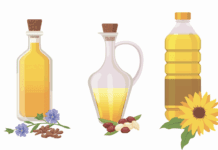“Reduced sodium” or “low sodium”— The term “reduced” means a product has 25% less sodium than the same food with a normal amount, so a “reduced sodium” choice is better than a conventional one. But even “reduced sodium” foods may be higher in sodium than those labeled “low sodium,” which can contain no more than 140 milligrams per serving. A “reduced sodium” can of beans, for example, should contain 25% less than the 311 milligrams of sodium found in a serving—233 milligrams, more than the “low sodium” limit. Check the Nutrition Facts panel to see what you’re really getting.
“Excellent source of fiber” or “extra fiber” — To be labeled an “excellent source,” a food must contain at least 20% of the DV of the nutrient; in this case, the DV for fiber is 25 grams, so at least 5 grams. “Extra” means that a product contains at least 10% more of the nutrient than a conventional alternative. So, for example, a puffed-rice breakfast cereal that naturally contains only 0.8 grams of fiber per cup could claim to have “Extra fiber” if it had 0.9 grams. Keep in mind, too, that not all fiber has equal health benefits.
“Sugar free” or “No added sugar” — Foods labeled “sugar free” contain less than 0.5 grams of sugars per serving, so you know you’re getting very little sugar. A product with “no added sugar,” however, can contain any amount of naturally occurring sugars and could still be quite high in calories. If the calories are not high and the food is a good source of healthy nutrients, it might be a good choice.
“No high-fructose corn syrup” or “No added sugar” — This comparison is a bit different. Just because a product is not sweetened with high-fructose corn syrup doesn’t mean it contains no caloric sweeteners. To avoid all, opt for “no added sugar.”
“Low fat” or “Low in saturated fat” — Foods labeled “low fat” can contain as much as 3 grams of total fat per serving, while “low in saturated fat” products are limited to no more than 1 gram of saturated fat (but may contain any amount of healthier unsaturated fats). Experts agree that too much emphasis has been placed on reducing total fat, and that the focus should be on limiting saturated fat.
“Low calorie” or “Light” — Again, “low calorie” signifies a definite amount—no more than 40 calories per serving—while “light” is a relative term meaning 25% fewer calories as well as less fat. So the choice depends on the food.



















